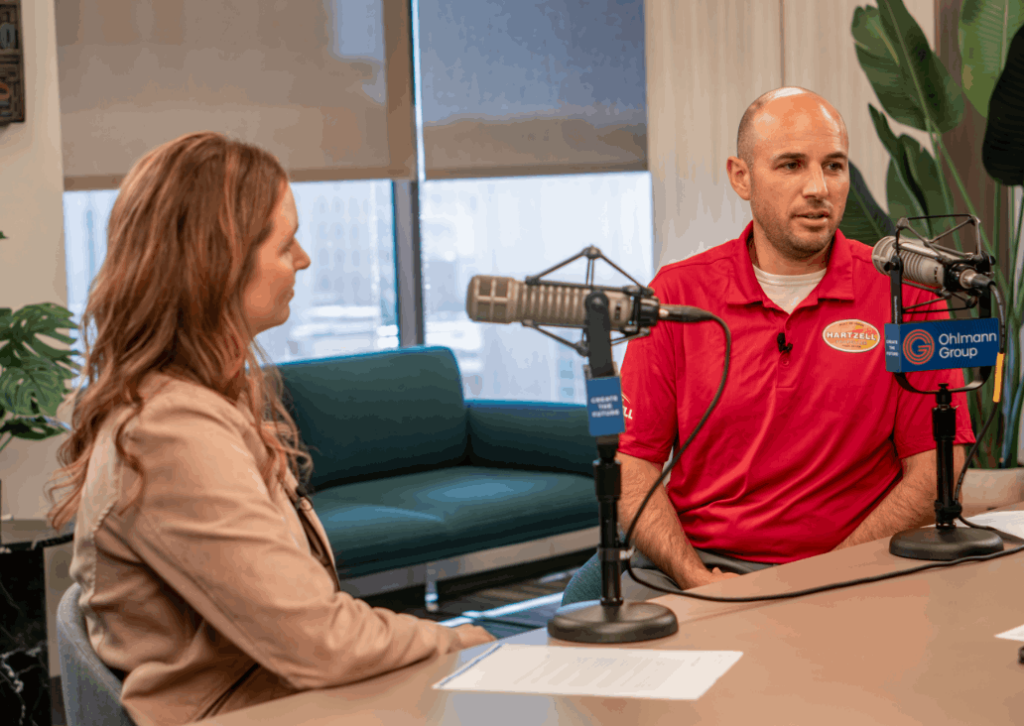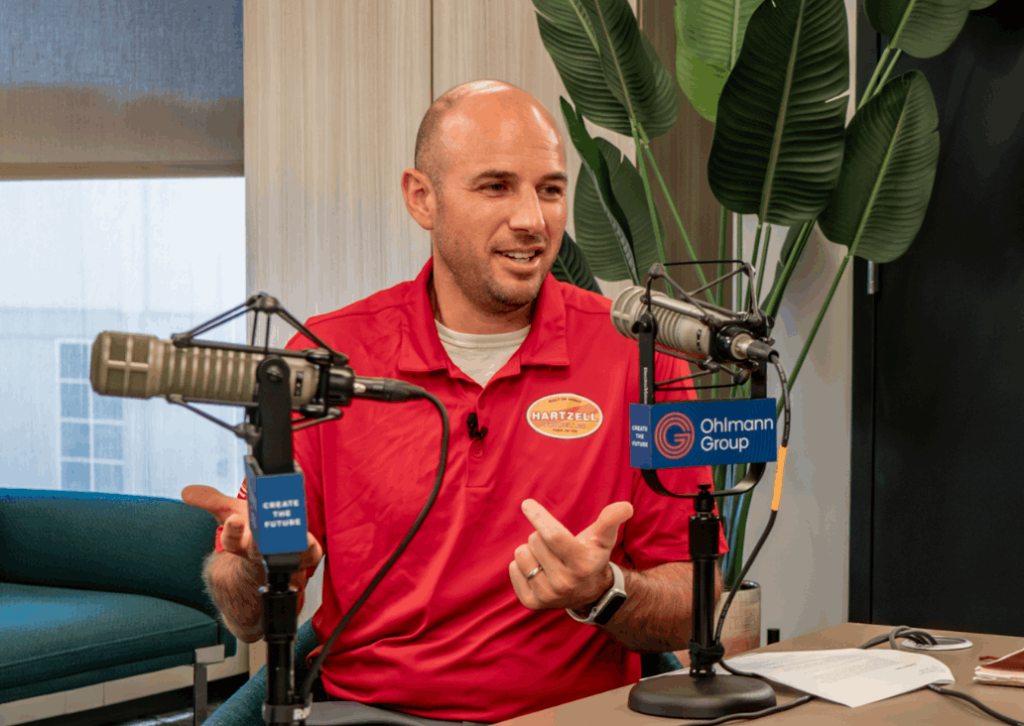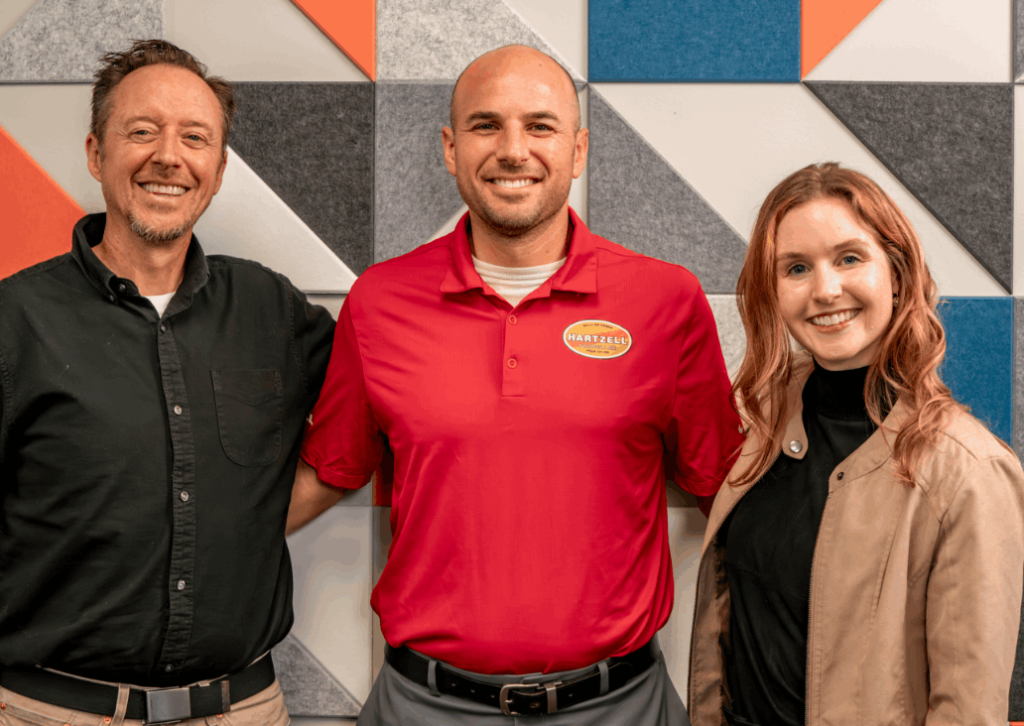JJ Frigge is recognized globally as the president of Hartzell Propeller, the world leader in advanced aircraft propeller design and manufacturing. He’s also well-known locally, channeling his passions back into his hometown of Troy, Ohio.
In this episode, hear more about Hartzell’s fascinating history dating back to the Wright Brothers, innovations in the world of electric aviation, and JJ’s take on Creating the Future in his community.
Listen Now!




Episode Transcript
David:
Welcome to Creating the Future. I am David Bowman —
Evelyn Ritzi:
And I’m Evelyn Ritzi.
David:
And today we are joined by JJ, Frigge, President of Hartzell Propeller. JJ, thank you for joining us today.
JJ Frigge:
Yeah, thanks for having me. It’s great to be here.
David:
So Dayton is known for creativity and for innovation, and everyone knows our biggest point of pride is we are the birthplace of flight. If anyone’s from around here, they may have heard that once or twice. What people might not know is that Hartzell Propeller has an essential role in that history, and legacy of aviation. There is an unbelievable kind of origin story with your company that dates all the way back to the Wright Brothers. So it could tell us, tell the listeners out there, the sort of back story on Hartzell Propeller and how it came to be.
JJ:
sure I’d be happy to I love telling this story. So back in 1917, everybody’s familiar in the Dayton area, at least with the Wright house here in Oakwood. And what you might not know is that the Hartzell family had a house right next door. They were neighbors and friends, and at the time, the Hartzell family was running a lumber mill and wagon manufacturing business up in Pickwell, Ohio, about 20 miles straight up the Miami, Miami, Great Miami River. And as they were talking between the Hartzell family and Orville Wright, it came to be that Robert Hartzell, who was in university at University of Cincinnati, was thinking of dropping out of college to be a barnstormer. And that didn’t sit well with his family. And so Orville and George Hartzell got together, and George asked Robert to start a propeller division in Piqua at their lumber mill and wagon business. So that’s how Hatzell Propeller got started. Robert started the propeller division in 1917, and the Dayton Wright airplane company run by Orville Wright, was our very first customer.
David:
That’s absolutely amazing.
JJ:
Yeah, pretty cool.
Evelyn:
And today, Hartzell is a global company that makes 1000s of propellers a year, and you are leading the charge as president. Can you talk a little bit about your background and how you landed at Hartzell?
JJ:
Sure, I’d love to Yeah. Hartzell, as you said, we’re a global company, and 400 employees all still in Piqua and growing, and you know, it’s been a great journey for the business, as well as me personally. So my background is, I was born in Piqua, raised in Troy, so I’m a local Miami County resident most of my life, and went to University of Notre Dame. Loved the football team since I was a little kid. And after graduating, I started at the IAMS company in Vandalia, Dayton area on Poe Avenue. And at the time, they had just been purchased by Procter and Gamble. So essentially, I was a Procter and Gamble employee working at the IAMS company. I did that for 10 years, worked in Vandalia and then Mason, and then the home office in downtown Cincinnati with Procter and Gamble. And then I had a friend of mine who had come to Hartzell a few years before me, and we knew each other, and he called and said, Hey, would you like to interview for this job at Hartzell. And I said, Well, sure, it’d be kind of an interesting opportunity to get back to, essentially, our hometown. My wife is also from Troy, and so I interviewed and really enjoyed the company, the people that I met, I kind of got a really good sense for the DNA, the company right out of the gate and here we are, almost 13 years later, I’ve been at Hartzell. Started as the controller back in late 2011, you know, kind of navigated my way through, Executive Vice President, General Manager, and then was promoted to President in 2020, so January of 2020, right before COVID broke in March. So it’s been a bit of a journey. And, you know, there’s certainly no playbook for that sort of thing, but we’ve navigated our way through it, and the business is doing well today, and I’m enjoying it.
David:
So you came from that P&G, IAMS world, and we’ll touch on your love animals right down the road, but even before Hartzell, did you have an interest, a background with general aviation? Reason I ask is that company doesn’t just make propellers, right? The saying you guys use frequently is aviation is in our DNA, right? And it is. It’s just so deeply ingrained into everybody there, yeah, and I know it’s deeply ingrained in you now, anytime you talk to you, you’re passionate about it. Was that a passion that built over time? Or is that something sort of, I always was interested in that kind of thing?
JJ:
No, it’s a great question. So it’s definitely since I was young, my best friend and I, his dad, would take us to the Dayton air show pretty much every year, and for me to hear the military planes buzzing over and watch the Blue Angels or the Thunderbirds, was so cool. And we’d go around to all the little recruiting stations and take the posters home with us. And my wall of my bedroom, since I was probably 10 years old, was just covered with cool pictures of military airplanes. So I’ve really felt, you know, a connection to aviation, yeah, you know, since I was little, and now being in the general aviation world, and we do a little bit of military application as well, but just seeing the passion that enthusiasts have for aviation and pilots have it’s, they’re their own breed. I mean, to be a pilot means that you’re dedicated, you know, to safety and you know protocols and knowing what you’re doing and having a good understanding of situations and and all kinds of things. So, you know, for me, being a pilot has always been a little bit out of reach because of a medical issue, but I really, really enjoy general aviation and being in this industry, it’s a great collection of people, yeah, with a common, shared interest and passion. And it really brings people together.
David:
It really is like a family or a culture in and of itself, which is really sure is, yeah. So different cultures, engineering, right, like and it’s, to me, fascinating, because when I think of engineers broad brush strokes, but I think of people who are trying to eliminate risk and make things predictable, right, yet your company is known for innovation, right? Pushing the envelope, doing things slightly differently, doing things better always. How are we pushing the limits and the boundaries of what can be done right in propeller flight? So talk about, how do you cultivate that culture of creativity when within sort of a group of engineers, right, who are sort of, you got to be careful with creativity in the world of engineering, particularly when you’re 1000s of feet above the surface of the Earth, right.
JJ:
So it’s a it’s a balancing act, right? And we’re constantly balancing, you know, pushing the envelope on performance and how we can enhance the propeller system versus number one job is safety and quality all the time, right? Quality is our number one operating priority. It has been right up there for, you know, for decades. And of course, safety goes without saying. You know, nobody comes to work to get hurt, and certainly we’re not going to put products in the market that are anything but 100% safe. So, we spend a lot of time doing conceptual reviews, design reviews, and then we go fly hardware, right? And we have, what’s really unique, at least in the propeller world, is that we have our own organization, delegation of authority through the FAA, so we’re able to actually test all of our parts in our test lab that we operate and fund, and take those parts all the way through a fatigue analysis and a fatigue risk profile that will eventually lead us to a certification path, which then we work with the FAA to certify the propeller system that we were hosting some guests a couple years ago, and I like to tell this story too. We checked in with the FAA just to see how we ranked in terms of overall certification data on file. And they told us that we have more cert data and more cert packages on file with them than any company in the US. Oh, my God, right. And includes Boeing and Textron and, you know, the big, you know, commercial aerospace folks. And it’s because we have so many unique propeller designs that, you know, we’re trying to maximize performance for our customers and type design to what missions they’re looking for. But it’s this continuous innovation and life, but lifeblood of product improvements that that we hold in very high regard as well. So, you know, we have a strong engineering staff. We do our own certification work with the FA is oversight, and it’s a really good combination to always prioritize safety and quality, but also push the bounds of what’s possible, right? Because physics don’t change. I say that all the time, but material properties do, right? And we’ve, you’re now, you know, investing heavily in composites and automation on the shop floor to make parts to the same spec all the time. Time, as opposed to manual processes, where you have, you know, the more of a human factor. And so there’s just lots of things that that go into the overall equation. But for us, the right balance has always been prioritizing safety and quality, but pushing ourselves on innovation and product improvement,
Evelyn:
and that idea of continuous innovation makes us think of the future of flight. And the hot topic around the world really is sustainability, electric flight, advanced Air Mobility, if you’re familiar with that term. And here in Dayton, we’ve seen several larger companies start to make their marks, such as Joby and Beta technologies. Can we talk about how Hartzell is actively collaborating and partnering with some of these companies to really drive forward this future of flight?
JJ:
Yeah, so general aviation customers like Cirrus and Piper and Pilatus and Textron, there’s this pie that we call it, of general aviation that is very stable and is, you know, growing slightly, especially since COVID, the need for general aviation has increased. But then there’s this whole other pie that’s being sort of stirred up and baked right now, Evelyn, as you mentioned, and it’s called Advanced Air Mobility, Urban Air Mobility, whatever you want to call it, electric hybrid, vertical takeoff. There’s this whole new, emerging pie that’s being created. And the exciting part for us is that we think it’s a complimentary piece to general aviation. We don’t think there’s going to be a whole lot of crossover in terms of negative impact to the current market. And also the products in our portfolio that we have now are very, very similar to what this AAM world is going to need. So again, we’re going to go type design some things for some customers. We’re already working with beta, and we’re already working with several others that we’re not quite allowed to talk about yet. But you know, there’s, there’s going to be hard soil propeller systems, type designed for these new vertical takeoff AAM, Urban Air Mobility, types of vehicles that are going to meet the mission profile and ultimately make it to market. Now, I will say, you know, there’s over 100 companies and startups playing in this field. There’s a lot of investment happening, and as we all know, most of them won’t make it through certification and make it to market. But you know, we’re working with the 10 or 12 that we really think have strong concepts, strong technical leaders at those companies, well funded. And, you know, we think a couple of them will make, will make it, for sure.
David:
I say it’s really cool when you think about your roots, right? That story you told of like, hey, we were right there at the beginning of general aviation. Yeah, you’re right there at the beginning of this phase of aviation,
JJ:
right? It’s really cool to see, you know, what’s happening in the Dayton area, Evelyn, to your point, at the, you know, Springfield airport, and you know, the surrounding area, the investment is still happening. And you know, it’s still really a hub for that innovation in the aviation sector.
David:
And so you were born in Miami County, right, as you mentioned, and you’re not just a leader in your company. You’re a leader in the community up there. And so what makes Miami County so unique and special to you, and why is it important that Hartzell and then you personally play an active role in shaping kind of call it, that culture of Miami County.
JJ:
I think that we’re fortunate and unique in the fact that you know our county, whether it’s Miami County or even Montgomery County, I think there’s a lot of folks that are lifelong residents, yeah, and there’s a sense of community and a sense of pride and a sense of mutual connection that is really, really important. And I think that is really what’s what makes our our county special. If, if, if I could be so bold as to kind of broaden it out, I think that the connections that we make in the county and the investments that we make, either as businesses or as individuals with our time and talents and resources are, are what makes it a better place. And, you know, I’m deeply committed to doing what I can do as a business leader, but also as just, you know, a normal guy who wants to go volunteer some time or coach a sports team, or, you know, just, just make an impact in the small ways that help others. Yeah,
Evelyn:
Yeah, and talk about making an impact. Something else we know that you’re passionate about, it’s near to your heart, is animals, animal welfare. Can you share a little bit about the new animal shelter and the efforts there to build that in Miami County?
JJ:
Yeah, so in Miami County, we are, I’m on the board of Miami County partners for animal welfare, MCPAW. And I give my wife a ton of credit for this. She’s a veterinary technician and has just shared with me her love for animals, and now my love for pets are we have, we have six dogs and 10 cats and so, goodness. So she’s busy. Taking care of our critters at home, but you know, the one thing I would say is that, you kno,w they add to your life in ways that you never would imagine. And so MCPAW is really a private nonprofit dedicated to raising funds for a new in partnership with Miami County government raising funds for a new animal shelter. So our current shelter is out by the fairgrounds, just north of Troy, and it’s over 50 years old. It’s got no climate control. It’s got really poor ventilation, and a big piece of it is a garage area that’s being used to house the overflow dogs and cats that come in. The great thing is, it’s run by a fantastic group of folks. Rob Craft is the director and they have, over the past several years, turned it into a no-kill shelter, which is phenomenal. So, you know, the point is that we need a new facility. We’ve got land designated to us by the county for that, and we’re in the early stages of the capital campaign. I’m proud to be on that board and try to help raise seven and a half million dollars, which is no small amount, but it’ll really set the, you know, the animal shelter up for many decades to come, in terms of matching up the facilities with the needs of the county.
David:
I think that’s just fantastic. Yeah, so one last question we like to ask our guests, and I think you’ve already sort of touched on it in a lot of different ways, but if, if you could maybe sum that up, what’s the future that you want to create?
JJ:
So, you know, I think it’s really simple to say, but it’s got a lot of different rabbit holes to go down. For me, I want to leave it better than I found it, whether that’s the company that I work for, or the family that I share or the community that I live in, I really want to leave it better than I found it. And I think if you start each day with that sort of mindset, then you lead yourself towards volunteering or serving, or, you know, stepping up to be a leader. And for me, leading from the front has always been sort of my goal. And, you know, don’t ask somebody to do something that you wouldn’t do yourself, right? And so I would just, I think we all have a great opportunity to improve our communities and improve, you know, the day-to-day lives of ourselves and others, and that’s ultimately what I’m trying to do.
David:
I’ve known you for about a decade now, and I see you living that every day and through that, just through knowing you, I’m better, so I appreciate you coming today to join us and sharing thoughts on the podcast and everything that you do for the community.
JJ:
Well thanks, David, I would say the same about you and Evelyn as well. So great people and proud to, you know, be friends and colleagues and share our work lives and personal lives in this great community. So thanks for having me.

